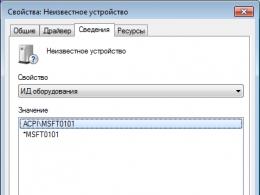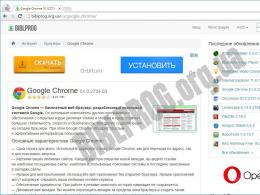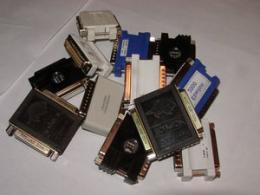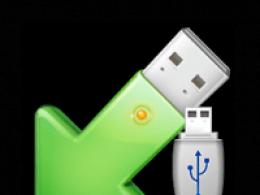A guide to file managers on Linux. Midnight Commander - console file manager for Linux Copying and moving files
All of us, both server administrators and users regular computers We often deal with files. It is important to work with files in an environment that is convenient for us, as this process can take quite a lot of time. We often open, delete, move and rename files. Therefore, in this article, let's look at how to choose a file manager for Ubuntu. By default, Ubuntu comes with Nautilus, but it may not suit everyone with its appearance and functionality; we will look at seven more different file managers, as well as how to install them.
Not everyone knows about the wide selection of file managers for Linux. Or they do not fully realize the capabilities of the programs they know about. There are different file managers for Ubuntu and there are plenty of them, as well as other programs. Here are the most popular ones:
- Midnight Commander
- Dolphin
They are all excellent file managers. There are both simple and multifunctional ones. You can choose a file manager that suits your needs. Midnight Commander and Dolphin are my favorite file managers. I use them quite often.
All of these file managers can be customized to your liking. The most customizable are Krusader and Konqueror. Midnight Commander is the only file manager with a console interface, but it also has many settings.
How to change default file manager in Ubuntu
If you decide to change the ubuntu file manager to another, it is not so difficult. Install the program you like and edit a few files to context menu worked with the new file manager.
And you need to correct the files:
/usr/share/applications/nautilus-home.desktop
/usr/share/applications/nautilus-computer.desktop
Replace the lines:
TryExec=nautilus
Exec=nautilus
TryExec=file_manager
Exec=file manager
And now the same thing in the file:
/usr/share/applications/nautilus-folder-handler.desktop
TryExec=file_manager
Exec=file_manager %U
In Kubuntu, the default file manager is configured in System Settings. Now let's move on to the review of file managers for Ubuntu.
Midnight Commander
Midnight Commander is a file manager with an interface command line(cli). It is especially useful when there is no way to launch a graphical shell, but can also be used as the main file manager in a graphical interface. It can be run in almost any command line shell and even in an SSH session.
You can launch Midnight Commander from the command line by running:
The screenshot above shows Midnight Commander in one tab of the Ubuntu terminal emulator. User interface The program is divided into two panels, each of which displays the contents of the directory. The top of each panel displays the current directory. Navigation is done using the arrow keys. The Enter key is used to open a folder.
At the very top of the program there is a menu with program settings, left and right panels, as well as various operations for files. At the bottom of the window, information about the selected file or directory is displayed, as well as a row with function keys. You can simply press the desired function key to quickly perform this or that action. Also here you can see a terminal line for quickly executing commands in the current directory.
You can install Midnight Commander with the command:
sudo apt-get install mc
Krusader is an exceptional file manager that uses the concepts of Midnight Commander in a GUI. It also uses a two-pane interface, but also supports many additional functions. It supports navigation using the keyboard and, as usual, using the mouse.

Krusader also has two panels that display the contents of a directory, but there are also tabs that allow you to open multiple folders in one panel.
On each tab you can configure the file display mode. In the screenshot, the files are displayed in detailed mode- icon, name, size, creation date, owner and access rights.
There is also a menu at the top of the window, and a line of function keys and a terminal at the bottom. Krusader automatically saves your current directories and display settings, so when you open the program, you'll be back in the folders you left it with last time.
Among the useful features, we can note support for the FTP and samba protocols, which simplifies access to files on remote servers.
To install this best Ubuntu file manager do:
sudo apt-get install krusader
It is important to note that it is written in Qt, and will take with it all of Qt and several KDE libraries.
Konqueror is another powerful file manager from the standard KDE suite. He has one interesting feature- in addition to accessing files, here you can enter the URL and view Internet pages.
Another feature of this file manager is the ability to open several tabs, in each of which you can open a separate directory.
In the picture, the program window is divided into three parts on the right and a sidebar on the left. The directory tree sidebar is used to quick navigation by file system.

What I especially like about Konqueror is the sidebar that makes it easy to find necessary files, navigate the file system, and quickly delete unnecessary directory trees.
The program interface is similar to Krusader and Midnight Commander, but there is much less functionality. Instead of two standard tabs, here you can create several panels and arrange them as you wish. You can navigate through tabs and directories using either the keyboard or mouse.
Here you can also configure the file display mode for each separate tab, but there is no automatic saving. But you can manually save the location and tabs that need to be launched every time you start the program.
To install on Ubuntu use the command:
sudo apt-get install konqueror
Double Commander
This is another great file manager in the style of Midnight Commander and Krusader. But this time it is based on the GTK library, which means that it is perfect for those who want an excellent, feature-rich file manager and do not want to drag half of the KDE libraries into the system.

The interface is divided into two panels. Exceptional features include a built-in text editor, support for viewing files in HEX and binary formats, and support for working with archives. It also supports various networking opportunities, such as connecting via Webdav, FTP, Samba.
To install, run these commands:
sudo add-apt-repository ppa:alexx2000/doublecmd
$ sudo apt-get update
$ sudo apt-get install doublecmd-gtk
Dolphin
This is another file manager from KDE. Its interface is very similar to Konqueror, but it is more beautiful and functional. Here, too, it is possible to create several panels and tabs. There is also a sidebar with shortcuts quick access to the file system.

By default, only one panel opens, but there's nothing stopping you from adding another one and making Dolphin look like Krusader. But splitting panels like in Konqueror is not supported here.
Although tabs are supported here, they are not saved and after restarting the program, it starts with one tab in which your home folder is open.
Installed by Dolphin with the command:
sudo apt-get install dolphin
Nautilus is the default in Ubuntu and I couldn't help but say a few words about it. Here you can use there is support for multiple panels and tabs, there is also a sidebar with quick access shortcuts. It is a simple and stable file manager, great for beginners due to its simplicity.

Navigation through catalogs is carried out using arrows on the keyboard or mouse. There are hotkey shortcuts, but not as many as in Double Commander.
This is another lightweight and simple file manager. Perhaps even simpler than Nautilus. It looks and works the same.

You can install on Ubuntu with the command:
sudo apt-get install thunar
Another moderately simple Ubuntu file manager. Looks the same as the previous two. Tabs and most functions are supported for convenient work with files.

On the left side of the screen there is a panel with a tree view of the file system, just like in Konqueror. This file manager contains excellent functionality and at the same time a very simple interface.
To install:
sudo apt-get install pcmanfm
XFE
This is one of the most interesting file managers. In its interface it includes many features from Nautilus, Thunar and PcManFm but at the same time it is much more flexible.
As is known, in distributions Ubuntu The file manager is installed and used by default Nautilus, developed by the team Gnome. But if in previous versions Nautilus it was possible to enable two-panel mode (F3), then starting from the version Nautilus 3.6 this function absent.
In this short article, dear users Ubuntu, I would like to bring to your attention four two-panel file managers that are located in the repositories Ubuntu, and therefore in App Center: Midnight Commander; GNOME Commander; Tux Commander And Krusader:

1. Midnight Commander

GNU Midnight Commander– full-screen text file manager. It uses a two-pane interface and a built-in command shell. There is also a built-in editor with syntax highlighting and a viewer that supports binary files. The program supports a virtual file system (VFS), which allows you to work with files on remote machines(for example, on FTP servers, SSH) and with files inside archives, as with regular files.
Installation Midnight Commander very simple, just open it Ubuntu Application Center, enter the name in the search field and click the button Install or run the command in the terminal:
sudo apt-get install mc
2. GNOME Commander

GNOME Commander- fast and powerful file manager with graphical interface for desktop environment GNOME. It has a two-pane interface in the tradition Norton Commander And Midnight Commander.
Install GNOME Commander also possible from Application Center or in the terminal with the command:
sudo apt-get install gnome-commander
3. Tux Commander

Tux Commander- window file manager with two panels one next to the other, similar to popular file managers Total Commander And Midnight Commander.
Possibilities:
- two directory panels next to each other (vertical)
- interface with tabs, buttons for quick access to favorite directories
- customizable panel for quick access to removable media and network resources
- multilingual user interface
- functionality is expanded through a plugin system
- Extension-based actions on file types (file associations)
sudo apt-get install tuxcmd
4. Krusader

Krusader is an easy-to-learn, powerful, two-panel (Commander-style) file manager similar to Midnight Commander or Total Commander.
Provides all the file management features you could ever need.
Additionally: extensive archive processing capabilities, support for mounting file systems, FTP, advanced search module, viewing and editing functions, directory synchronization, comparison of file contents, powerful tools batch renaming of files and much more.
Supports the following archive formats: ace, arj, bzip2, deb, iso, lha, rar, rpm, tar, zip and 7-zip.
Supports the KIOSlaves mechanism, which makes protocols such as smb:// and fish:// available.
Krusader- Fully customizable, user friendly, fast, will look great on your desktop.
P.S. There are other two-panel file managers like
BeeSoft Commander 2.23
BeeSoft Commander a young project, a simple file manager, written in the spirit of the UNIX-way. According to the unwritten rule, the program should perform only its direct duties and nothing extra.
The file manager uses the QT library and is very fast to launch from the KDE environment. The toolbar is not customizable, but it contains virtually all the main functions of the program. You can work with multiple tabs. Right button mouse is responsible for selecting files tribute to the old tradition of Norton Commander. Many file operations are performed using function keys, according to the old standard also laid down by Peter Norton.
BeeSoft Commander contains a good FTP client that allows you to connect to several servers and save connection settings. The developers did not bother themselves with the implementation of viewing and editing various documents. With the built-in editor you can only change text documents. If other types of files are detected, the program either switches to HEX mode or displays a chaotic set of characters. Editing is not available in this case.
BeeSoft Commander does not require complex configuration. You can specify the fonts and colors of the panels, and adjust the width of the columns. And, in fact, this is where all the fun of traveling through the settings ends.
Official site: 
Worker one of the most unusual file managers. The first thing you should immediately pay attention to is that there is no need to install any additional graphics libraries other than X11.
All file manager controls are concentrated in numerous buttons located at the bottom of the application's working window. By clicking on the status bar, you switch groups of buttons. Each button calls a separate function. The functions can be either built-in Worker tools or external utilities designed for processing files.
Worker is closely integrated with Midnight Commander and allows you to use the archive processing rules of the console file manager. In addition, by default, MC is used as a file editor (Edit File function).
The Worker distribution only includes a viewing tool text files. All other actions (viewing graphics and videos, editing any types of data...) are left to you external programs. The default text editor is xedit, which is not surprising. xedit also only uses the X11 library.
Among the predefined functions (buttons) you can find audio conversion, graphics conversion, device mounting and much more.
The file manager is very unusual, which, of course, will make it difficult to master from scratch. On the other hand, all competitors either use powerful graphics libraries (QT, GTK) or work in text mode. Worker in this light seems to be a kind of compromise solution.
Pivot table
| GUI | + | + | + | + | + | + | - | + | - | + | + |
| Graphics library | QT | GTK2 | GTK1 | GTK2 | QT | QT | - | GTK2 | - | GTK2 | X11 |
| Tabs | + | - | - | - | + | + | - | - | + | - | - |
| FTP client | + | - | - | + | + | + | + | + | - | - | + |
| FTP:// protocol | - | - | - | - | + | + | - | + | - | - | - |
| SMB:// protocol | - | - | - | + | + | + | - | + | - | - | - |
| HTTP:// protocol | - | - | - | - | + | - | - | - | - | - | - |
| Document thumbnails | - | - | - | - | + | + | - | + | - | - | - |
| Text editor | + | + | - | - | - | + | + | - | + | - | - |
| Viewing Images | - | - | - | + | + | - | - | - | - | - | - |
| Watch video | - | - | - | - | + | - | - | - | - | - | - |
| View HTML | - | - | - | - | + | + | + | - | - | - | - |
| View RTF | - | - | - | - | + | + | - | - | - | - | - |
| View DOC | - | - | - | - | + | + | + | - | - | - | - |
| HEX editor | - | - | - | - | - | - | - | - | + | - | - |
| File type highlighting | - | - | + | + | - | - | - | - | + | - | - |
| Quick Folders (Bookmarks) | - | + | - | + | + | + | + | + | - | + | - |
| Folder history | - | + | + | + | + | + | + | + | + | - | - |
| Frequently visited folders | - | - | - | - | + | + | - | - | - | - | - |
| Quick launch panel (menu) | - | - | - | - | + | + | + | - | + | - | - |
| Plugins | - | + | - | + | + | + | + | - | - | - | - |
| Multitasking | - | - | + | + | + | + | + | + | - | - | - |
| BeeSoft Commander 2.23 | |
| emelFM2 0.1.6 | |
| Gentoo 0.11.55 | |
| GNOME Commander 1.2.0 | |
| Konqueror 3.5.2 | |
| Krusader 1.70.0 | |
| Nautilus 2.12.2 | |
| Tux Commander 0.4.101 | |
| Text file managers and Worker |
This is explained simply. The work environment is an important element, but essentially an auxiliary one. The main user tool - application program. The user may, for some time, put up with an inconvenient method for launching applications or an unpleasant color of icons. But if in some new text editor If the keyboard shortcuts that are familiar to it do not work, there will be no transition to it.
This, in turn, can create problems for migrants. Without the burden of the past behind them, they choose objectively best tools, but thereby limit the ability of experienced users to give them any advice. By the way, this is often observed in practice and is perceived by some newcomers as unfriendliness of veterans. Although in reality their recommendations are quite sincere - they can help with setting up vim, but are practically unfamiliar with kate.
A significant part of experienced Linux users works with console file managers, preferring them to the more visual Dolphin or Nautilus. Although they use KDE or GNOME desktops.
Thus, even beginners should know what is commonly called the Linux classics. Including console file managers.
1 Midnight Commander
Console file manager Midnight Commander
This is the most popular console file manager running on Linux. The program is included by default in a large number of distributions. A lot of documentation has already been compiled for it, so learning the rules of working with the application will not be difficult for users of different levels of training.
MC supports everything basic operations with files: copying, renaming, deleting, changing owner and access rights, creating links, directories, etc. The program can work not only with local, but also remote file systems via FTP and SSH access.
The program also includes additional features: working with archives, built-in search, viewing and editing files using its own MCEdit module. Thus, relatively complex operations can be performed in MC.
The file manager interface is the usual two-panel one. Its effectiveness has long been proven by practice.
The application is completely localized.
Sudo apt-get install mc
2 Ranger
Ranger console file manager
This is a console file manager. By default, its interface is three-panel: the first column displays a list of directories, the second - a list of files, and the third is intended for viewing files, including graphic formats. At the same time, all operations standard for programs of this type are supported, although not in the most obvious way.
However, the lack of visibility makes Ranger not very useful for copy and move operations. Strengths of this application - navigation, search and browsing. This is greatly facilitated by a convenient bookmark system.
The program is configured through direct editing configuration file. This may seem inconvenient, although in practice this is not the case thanks to the intuitive design of this file. The user can define the number of columns, sort order, status bar appearance, color scheme, etc.
Distributed under the terms of GNU GPLv3.
Sudo apt-get install ranger
3 WCM Commander
Console file manager WCM Commander
This is a file manager, which is most often called a clone of the famous FAR. Of course, experienced users will say that this is somewhat exaggerated, but nevertheless the similarity is quite close, at least at the level of the most popular operations. In particular, the keyboard combination Shift+F1, which is familiar to many, works exactly the same.
The additional capabilities of WCM Commander are quite serious even for experienced user: editor with syntax highlighting for the most common programming languages and the ability to change encodings, access to remote file systems via SMB and FTP/SFTP with the ability to launch files, history and input completion, support for external color schemes etc.
The program is perfectly Russified, and much deeper than the interface points. In particular, the text search function allows you to use all Russian language encodings at once.
Distributed under the terms of the MIT license.
4 Vifm
Console file manager Vifm
This is a console file manager for Vim fans. Even the name of the program stands for Vi File Manager.
The main feature of vifm is vim-style controls. For example, to move through files you can use not only the arrow keys, but also the “j” and “k” buttons, go to the last file in the current directory by pressing “G”, etc.
Vifm allows you to use directory and file labels to quickly navigate to the desired location by hotkey. Searching in vifm is done in the same way as in vim - by clicking on “/”. The application has its own built-in commands: “com” to display a list of custom commands, “marks” to show marks, “only” to hide the second column, etc.
Distributed under the terms of GNU GPLv2.
Sudo apt-get install vifm
5 Last File Manager
Console file manager LFM
This is an easy to use console file manager. By default, the program has a traditional two-panel view, although it can also work in single-panel mode.
Both externally and functionally, Last File Manager is very similar to Midnight Commander. At least, a user who has mastered one program will not have problems with another - the same keys are responsible for the most popular operations.
Distributed under the terms of GNU GPLv3.
Users, unlike testers and enthusiasts, are always conservative. Linux users are no exception. This is especially noticeable not in working environments, but in specific application programs, “loyalty” to which remains for a very long time.
This is explained simply. The work environment is an important element, but essentially an auxiliary one. The main user tool is the application program. The user may, for some time, put up with an inconvenient method for launching applications or an unpleasant color of icons. But if the usual keyboard shortcuts do not work in some new text editor, then there will be no transition to it.
This, in turn, can create problems for migrants. Without the burden of the past behind them, they choose the objectively best tools, but thereby limit the ability of experienced users to give them any advice. By the way, this is often observed in practice and is perceived by some newcomers as unfriendliness of veterans. Although in reality their recommendations are quite sincere - they can help with setting up vim, but are practically unfamiliar with kate.
A significant portion of experienced Linux users work with console file managers, preferring them to the more intuitive Dolphin or Nautilus. Although they use KDE or GNOME desktops.
Thus, even beginners should know what is commonly called the Linux classics. Including console file managers.
Midnight Commander
This is the most popular console file manager running on Linux. The program is included by default in a large number of distributions. A lot of documentation has already been compiled for it, so learning the rules of working with the application will not be difficult for users of different levels of training.
MC supports all basic operations with files: copying, renaming, deleting, changing owner and access rights, creating links, directories, etc. The program can work not only with local, but also remote file systems via FTP and SSH access.
The program also has additional features: working with archives, built-in search, viewing and editing files using its own MCEdit module. Thus, relatively complex operations can be performed in MC.
The file manager interface is the usual two-panel one. Its effectiveness has long been proven by practice.
The application is completely localized.
Ranger
This is a console file manager. By default, its interface is three-panel: the first column displays a list of directories, the second - a list of files, and the third is intended for viewing files, including graphic formats. At the same time, all operations standard for programs of this type are supported, although not in the most obvious way.
However, the lack of visibility makes Ranger not very useful for copy and move operations. The strengths of this app are navigation, search and browsing. This is greatly facilitated by a convenient bookmark system.
The program is configured by directly editing the configuration file. This may seem inconvenient, although in practice this is not the case thanks to the intuitive design of this file. The user can define the number of columns, sort order, status bar appearance, color scheme, etc.
Distributed under the terms of GNU GPLv3.
WCM Commander
This is a file manager, which is most often called a clone of the famous FAR. Of course, experienced users will say that this is somewhat exaggerated, but nevertheless the similarity is quite close, at least at the level of the most popular operations. In particular, the keyboard combination Shift+F1, which is familiar to many, works exactly the same.
Additional features of WCM Commander are quite serious even for an experienced user: an editor with syntax highlighting for the most common programming languages and the ability to change encodings, access to remote file systems via SMB and FTP/SFTP with the ability to launch files, history and input completion, support for external color schemes and etc.
The program is perfectly Russified, and much deeper than the interface points. In particular, the text search function allows you to use all Russian language encodings at once.
Distributed under the terms of the MIT license.
Vifm
This is a console file manager for Vim fans. Even the name of the program stands for Vi File Manager.
The main feature of vifm is vim-style controls. For example, to move through files you can use not only the arrow keys, but also the “j” and “k” buttons, go to the last file in the current directory by pressing “G”, etc.
Vifm allows you to use directory and file labels to quickly navigate to the desired location using a hotkey. Searching in vifm is done in the same way as in vim - by clicking on “/”. The application has its own built-in commands: “com” to display a list of custom commands, “marks” to show marks, “only” to hide the second column, etc.
Distributed under the terms of GNU GPLv2.
Last File Manager
This is an easy to use console file manager. By default, the program has a traditional two-panel view, although it can also work in single-panel mode.
Both externally and functionally, Last File Manager is very similar to Midnight Commander. At least, a user who has mastered one program will not have problems with another - the same keys are responsible for the most popular operations.
Distributed under the terms of GNU GPLv3.






